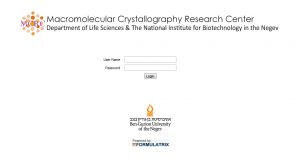The Macromolecular Crystallography Research Center has a state of the art facilities for setting up highthroughput crystallization experiments with a nano-liter volume of samples and for storing and monitoring the crystallization experiments at various temperatures.
 mar345= image plate detector, as well as cryogenic cooling system. to it plus a cryo-cooler
mar345= image plate detector, as well as cryogenic cooling system. to it plus a cryo-cooler
| Beam size at sample: | ≤ 250 x 250 μm |
| Beam divergence: | ≤ 5 x 5 mrad2 |
| Total flux: | > 6 x 108 photons/sec |
| Peak flux density at focal spot: | > 1 x 1010 photons/sec/mm2 |
| Focal distance: | 600 mm from source |
| Anode cooling: | air-cooling by fan |
| Mirror protection: | diaphragm vacuum pump with interlock to shutter |
Powerful software which provides the experimental design and which automates and tracks the crystallization process. It allows for the rapid creation of complex experiments and crystallization

A liquid handler that dispenses crystallization solutions for 24- as well as for 96-well grids rapidly and with high accuracy.

A fast and precise automated nanoliter dispenser for setting up crystallization experiments including sitting drops, hanging drops and seeding.

An automated imaging system for protein crystallization. This apparatus incubates and captures quality images of up to 250 crystallization plates on a user-defined schedule.

Rock Maker Web (Formulatrix)
Website for users to follow up on the crystallization experiments

Computing Facilities
The MCRC has various workstations running under Linux operating system. Commonely crystallographic softwares for all the stages of a crystal structure determination (data collection, processing, phasing, refinement, molecular graphics, structure analysis and validation) and modelling are available for users to process and analyze their data.

